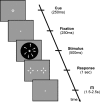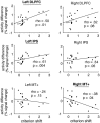Prior expectation modulates the interaction between sensory and prefrontal regions in the human brain
- PMID: 21775617
- PMCID: PMC6622631
- DOI: 10.1523/JNEUROSCI.1478-11.2011
Prior expectation modulates the interaction between sensory and prefrontal regions in the human brain
Abstract
How do expectations about the identity of a forthcoming visual stimulus influence the neural mechanisms of perceptual decision making in the human brain? Previous investigations into this issue have mostly involved changing the subjects' attentional focus or the behavioral relevance of certain targets but rarely manipulated subjects' prior expectation about the likely identity of the stimulus. Also, because perceptual decisions were often paired with specific motor responses, it has been difficult to dissociate neural activity that reflects perceptual decisions from motor preparatory activity. Here we designed a task in which we induced prior expectations about the direction of a moving-dot pattern and withheld the stimulus-response mapping until the subjects were prompted to respond. In line with current models of perceptual decision making, we found that subjects' performance was influenced by their expectation about upcoming motion direction. The integration of such information into the decision process was reflected by heightened activity in the dorsolateral prefrontal cortex. Activity in this area reflected the degree to which subjects adjusted their decisions based on the prior expectation cue. Furthermore, there was increased effective connectivity between sensory regions (motion-sensitive medial temporal area MT+) and dorsolateral prefrontal cortex when subjects had a prior expectation about the upcoming motion direction. Dynamic causal modeling suggested that stimulus expectation modulated both the feedforward and feedback connectivity between MT+ and prefrontal cortex. These results provide a mechanism of how prior expectations may affect perceptual decision making, namely by changing neural activity in, and sensory drive to, prefrontal areas.
Figures






References
-
- Bar M. Visual objects in context. Nat Rev Neurosci. 2004;5:617–629. - PubMed
-
- Brainard DH. The psychophysics toolbox. Spatial Vision. 1997;10:433–436. - PubMed
-
- Donner TH, Siegel M, Fries P, Engel AK. Buildup of choice-predictive activity in human motor cortex during perceptual decision making. Curr Biol. 2009;19:1581–1585. - PubMed
Publication types
MeSH terms
Substances
LinkOut - more resources
Full Text Sources
